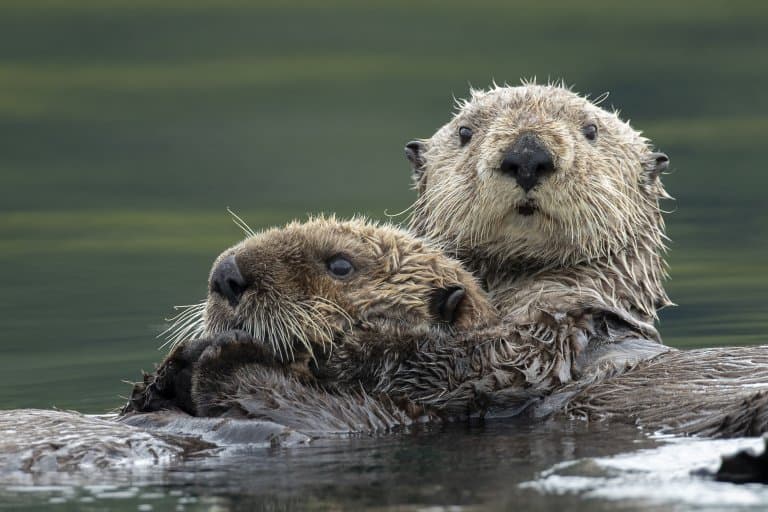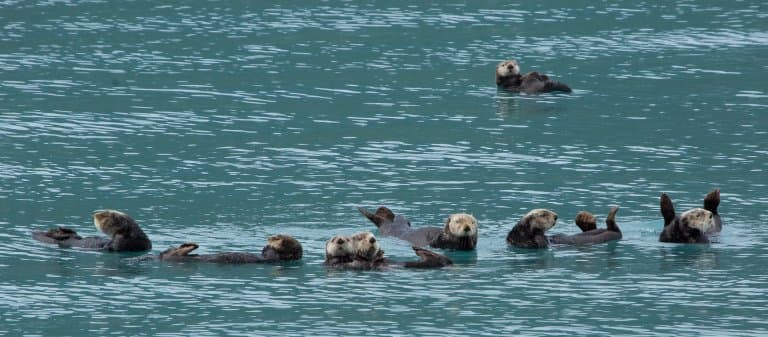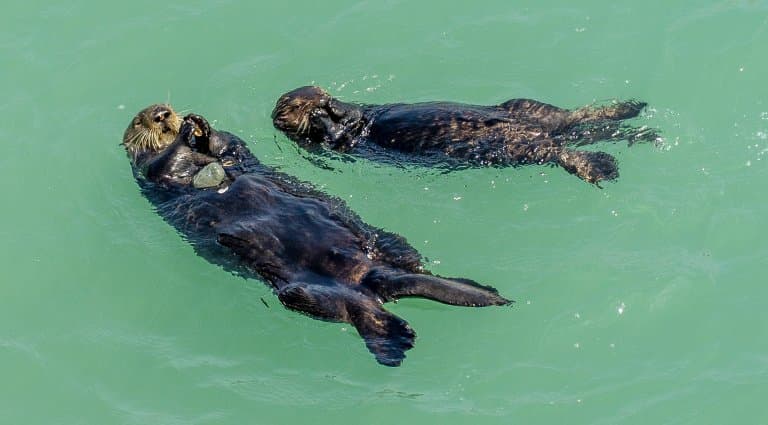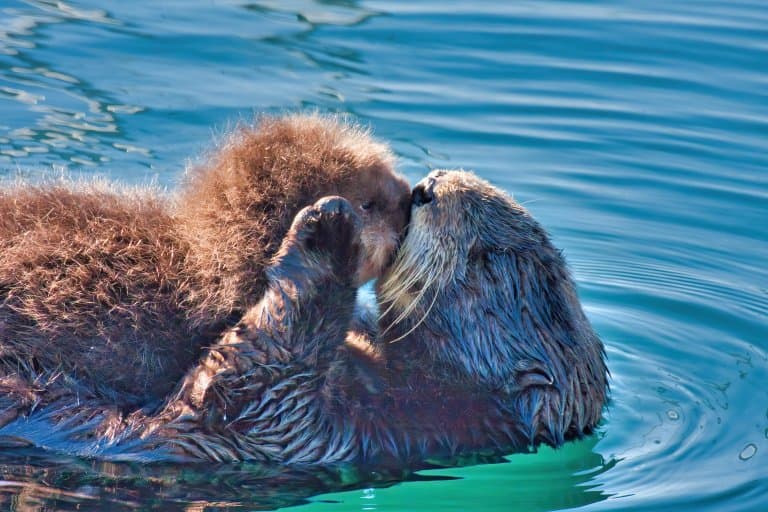Sea Otter Profile
Mustelids are so cool! And they get very little attention, but that’s probably the way they like it. In the family Mustelidae, there are killers that range from the bulky wolverines and badgers to the brilliantly named “least weasel”.
Most live on land, but some, like otters, spend much of their time in water. Sea otters, a different genus than their freshwater cousins, are much larger and spend almost all their time in the ocean.
These marine mammals are native to coasts of the northern and eastern North Pacific Ocean.

Sea Otter Facts Overview
| Habitat: | Coastal marine ecosystems, kelp forests |
| Location: | North Pacific, of North America, Russia, Asia and Canada |
| Lifespan: | Approximately 15-20 years |
| Size: | Usually 1.2 meters (4 feet) in length, up to 1.3m (5 feet) |
| Weight: | Up to 45 kilograms (100 pounds) |
| Colour: | Dark brown |
| Diet: | Varied seafood: sea urchins, abalone, clams, and crabs |
| Predators: | Orcas, sea lions, bald eagles, bears, coyotes, great white sharks |
| Top Speed: | 9km/h (5.6mph) under water |
| No. of Species: | 1 |
| Conservation Status: | Endangered (IUCN) |
Sea otters are the heavyweights of the mustelid family, and yet relatively petite compared with a lot of the vertebrates they share their habitats with.
They inhabit coastlines and nearshore environments, where it can dive to the sea floor to forage for prey such as, sea urchins, mollusks and crustaceans.
As furry mammals, they have little fat to protect them from the cold water, yet they overcome this with a fur density that piqued the interest of early human hunters, culminating in a devastating hunt that lasted centuries, almost wiping them out entirely.
New restrictions are helping, but a lot needs to be done to save these adorable, and hugely significant ecological engineers.
Interesting Sea Otter Facts
1. They’re the heaviest members of the weasel family
For a marine mammals, they’re actually one of the smallest, but sea otters have their recent origins on land, and compared with other mustelids, they’re the heaviest, and one of the largest in the family.
A big sea otter can weigh up to 45kg, that’s more than most dogs, and this isn’t blubber weight, either. In fact, they don’t have the same fatty privileges as other marine mammals, so they have to figure out how to stay warm in other ways.

2. They have the densest fur in the animal kingdom
The main way they do this is with their fur. This is the thickest fur of any mammal with up to 150,000 strands of hair per square centimetre, and early humans became aware of this quite quickly.
There’s archaeological evidence of otter hunts dating back thousands of years, primarily for their pelts, which would have made excellent, waterproof Winter clothing.
This fur contains a layer of air, which keeps water from the skin completely during dives, but it also reduces how deep and for how long the otter can forage, as, unlike blubber, this fur compresses at depth, reducing the thickness of the insulating layer and its effectiveness at depth.
3. They use tools
Sea otters are smart, and have learnt to use rocks to open shells. Sea otters will pound its prey with both paws against a rock on its chest.
They will also swim underwater with large stones, and use them to pry abalones off rocks. This can take some persistence and multiple dives!
This makes them one of the few mammal species to use tools.

4. They eat a lot
These seafood specialists spend a lot of time eating. The classic image of a sea otter floating around on its back smashing into shellfish with a rock is an accurate depiction of how they spend much of their time.
But they also hunt squid and octopus, and the occasional fish, if they can catch one. All in all, an otter-like this might consume 20% to 30% of its body weight each day. They even have a special pouch of skin in their arms that they can use to store food while they forage.
Their teeth are not sharp like the ones that shredded the Nutkins fingers, instead they’re blunted for crushing, rather than biting, reflecting their diet of hard-shelled gastropods, over the more fishy diet of freshwater otters. 1
5. They hold hands
Otters occupy habitats that have a lot of kelp around, and this is great for both hiding and anchoring themselves while they sleep. These are the only mustelid that gives birth in water, and they spend the vast majority of their time in the ocean.
As such, they have to prevent currents from separating them. To do this, they hold hands. And it’s adorable. But that’s only one of the weapons in their cuteness arsenal. 2
6. They’re cute, and they know it
Like all otters, sea otters are smart animals. In captivity, they routinely manipulate visitors into feeding them by using irresistible squeaks and cute little begging fingers while standing up on their back legs.
In the wild, they wave, cuddle, and squeak at one another while nibbling on urchins and clams.
Yet, do not mistake this cuteness for cuddliness. The late Terry Nutkins, one of the early heroes of wildlife television lost part of two fingers to an otter.
But there’s more to these animals than their relentless charm. 3
7. They’re a keystone species
Sea otters are so good at crushing urchins that it has a significant impact on their environment. The kelp forests they inhabit are one of the primary food sources of urchins, and without the presence of otters, the spiny herbivores are able to swarm the forests, causing rampant destruction to a biological structure that provides homes for countless marine animals. They’re one of the most productive ecosystems in the world.
As such, the otters hold the entire organisation together, and their presence is key to the success of a wide range of species. These forests are also sequesters of CO2, which makes the otters important to life elsewhere too.
8. Mothers act as a raft for pups
Sea otters are polygynous and males will partner with multiple females. They usually breed every year, and gestation is between 4-12 months.
Typically 1 pup is born and mothers will nurse them for 4-12 months and take up sole parenting duties. Mothers will act as a raft for pups, cradling them on her chest away from the cold water.
Sadly, it’s estimated only 25% of pups will survive their first year. Mothers have been known to carry their pups for days after a pup dies.

9. They were nearly hunted to extinction
While otter fur has been coveted for thousands of years, hunting by modern humans has presented an overwhelming force to the species.
During the 18th century, a devastating period, known as the Great Hunt, supplied increasing global demand for sea otter fur.
This led to the near extinction of the species, and the detriment of innumerable ecosystems they once inhabited, and by the 19th and 20th century, restrictions were needed to save Sea otters from total eradication. Their population fell from as high as 300,000 to just 1,000-2,000 in the wild. 4
10. And they’re now in serious trouble
Despite these restrictions, the species still struggles. They’re listed as Endangered by the IUCN, and populations are thought to still be in decline.
But it’s not only hunting that threatens them now, as urban runoff, poorly-processed human waste, oil pollution and conflicts with fisheries present them with a lot more to deal with. Human activity is also bringing new parasitic infections, and Sea otters have been found to harbour H1N1, which they can catch from human vectors.
11. Conservation has had mixed success
Sea otters need concentrated efforts across many industries in order to benefit from protection.
Shellfish fisheries complain that reintroductions decimate ‘their’ stocks of shellfish, and the unstoppable tide of urban expansion seems set to continue its wave of pollution into their waters.
Protected areas are key to their survival, but there remains a lot of work to be done if the conservation of Sea otters is to succeed.
Sea Otter Fact-File Summary
Scientific Classification
| Kingdom: | Animalia |
| Phylum: | Chordata |
| Class: | Mammalia |
| Order: | Carnivora |
| Family: | Mustelidae |
| Subfamily: | Lutrinae |
| Genus: | Enhydra |
| Species: | Enhydra Lutris |
Fact Sources & References
- Melissa Renwick (2021), “Indigenous hunting historically reduced sea-otter impact on shellfish, study finds”, Times Colonist.
- “Sea Otter”, National Geographic.
- Cassidy Merideth (2016), “11 Reasons Why Sea Otters Are The Cutest Animal Alive”, Odyssey.
- Hannah P. Wellman (2022), “Fur or food? Native American use of sea otters (Enhydra lutris) on the Oregon coast prior to European contact and extirpation”, Science Direct.
